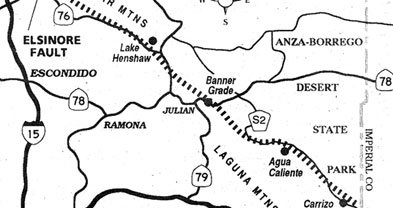 Facebook
Facebook
 X
X
 Instagram
Instagram
 TikTok
TikTok
 Youtube
Youtube

Like a subterranean knife-wound, the Elsinore Fault slices across the heart of San Diego County’s backcountry, promising an earth-shaking jolt or two during the next few millennia. Sputtering movements over geologic time along its opposing sides have shaped much of the county’s topography. And that particular topography has affected where you can easily drive and where you cannot. Here’s how you can trace our county’s share of the Elsinore Fault, by car or by bike, and by staying on pavement throughout the trip.
Start by heading south from Temecula on Pala Road. The fault passes under the road near the summit just beyond the county line, but with no visible trace at the surface. Turn left at Highway 76 and continue generally east, below the steep ramparts of Palomar Mountain — itself a “fault-block” range thrust upward several thousand feet. The Lake Henshaw reservoir lies ahead, occupying a broad, mountain-ringed basin of the sort geologists call a “sag pond.” The fault runs near the reservoir’s south shore.
On Highway 79, between Lake Henshaw and Santa Ysabel, the road elbows to the right at a summit and you pass over the fault once again. At Santa Ysabel, turn left (east) on Highway 78 toward Julian. Beyond Julian, follow Highway 78 down the corkscrew Banner Grade. While tracking this notorious stretch (or struggling to keep your cookies if you’re a backseat passenger), notice the conspicuous, notch-like traces of the fault at eye-level on the slope to the left across Banner Canyon. At the bottom of the grade, the fault skips over a low mountain pass, heading southeast, but you must detour east to stay on pavement, following Highways 78 and S-2 into the desert. You rejoin the fault just beyond the Box Canyon historic site on S-2.
The Elsinore Fault and Highway S-2 are nearly coincident over the next 25 to 30 miles. Look for fault traces skipping over the rocky hills southeast of the hot springs at Agua Caliente and also along the mountain slopes to the right, about four miles past Agua Caliente. Finally, pill off at the skims across the base of the prominent slope. Farther south and east, the fault sinks beneath the desert sands. Continue driving southeast to Ocotillo, where you can pick up Interstate 8 for an expeditious return to San Diego.
For more clues to spotting traces to this and other faults, see Phillip Kern’s Earthquakes and Faults in San Diego County.


Like a subterranean knife-wound, the Elsinore Fault slices across the heart of San Diego County’s backcountry, promising an earth-shaking jolt or two during the next few millennia. Sputtering movements over geologic time along its opposing sides have shaped much of the county’s topography. And that particular topography has affected where you can easily drive and where you cannot. Here’s how you can trace our county’s share of the Elsinore Fault, by car or by bike, and by staying on pavement throughout the trip.
Start by heading south from Temecula on Pala Road. The fault passes under the road near the summit just beyond the county line, but with no visible trace at the surface. Turn left at Highway 76 and continue generally east, below the steep ramparts of Palomar Mountain — itself a “fault-block” range thrust upward several thousand feet. The Lake Henshaw reservoir lies ahead, occupying a broad, mountain-ringed basin of the sort geologists call a “sag pond.” The fault runs near the reservoir’s south shore.
On Highway 79, between Lake Henshaw and Santa Ysabel, the road elbows to the right at a summit and you pass over the fault once again. At Santa Ysabel, turn left (east) on Highway 78 toward Julian. Beyond Julian, follow Highway 78 down the corkscrew Banner Grade. While tracking this notorious stretch (or struggling to keep your cookies if you’re a backseat passenger), notice the conspicuous, notch-like traces of the fault at eye-level on the slope to the left across Banner Canyon. At the bottom of the grade, the fault skips over a low mountain pass, heading southeast, but you must detour east to stay on pavement, following Highways 78 and S-2 into the desert. You rejoin the fault just beyond the Box Canyon historic site on S-2.
The Elsinore Fault and Highway S-2 are nearly coincident over the next 25 to 30 miles. Look for fault traces skipping over the rocky hills southeast of the hot springs at Agua Caliente and also along the mountain slopes to the right, about four miles past Agua Caliente. Finally, pill off at the skims across the base of the prominent slope. Farther south and east, the fault sinks beneath the desert sands. Continue driving southeast to Ocotillo, where you can pick up Interstate 8 for an expeditious return to San Diego.
For more clues to spotting traces to this and other faults, see Phillip Kern’s Earthquakes and Faults in San Diego County.
Comments